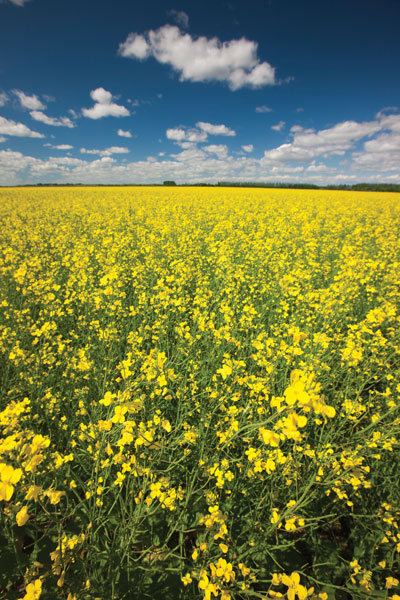
The Final Proof: October 2012
September 20, 2012
By Jane Dummer RD
Canola is still gaining ground seven years after the removal of trans fat as consumers get savvier about the kinds of fats they eat
Canola is still gaining ground seven years after the removal of trans fat as consumers get savvier about the kinds of fats they eat
 |
|
| The name canola is a contraction of Canadian and ola, which means oil. Photo: Canola Council of Canada |
Seven years ago, Canada became the first country in the world to introduce mandatory labelling of trans fat on pre-packaged foods. The intent was to help consumers make healthy food choices. This has kept commercial bakers busy reducing and eliminating trans fat in their products. One solution to achieve a healthier nutrition profile and reduce both saturated and trans fat can involve canola oil.
Shaunda Durance-Tod, a registered dietitian and the CanolaInfo manager at the Canola Council of Canada, explains.
“In the early 1970s, canola was developed using traditional plant breeding techniques to significantly reduce the levels of erucic acid and glucosinolates that were found in the parent rapeseed plant.” The name canola is a contraction of Canadian and ola, which means oil. “Canola is low in saturated fat, has a high amount of monounsaturated fat and it is a healthy alternative for sources of trans fat.”
One of the most commonly used packaging elements impacting food purchase is the ingredient list.
Consumers are becoming more aware of the types and quality of fat. According to the International Food Information Council (IFIC), 66 per cent of consumers use the ingredient list to specifically look at the type of fat or oil the product contains. Canola is the second most widely used oil in the North American food industry. Production of canola continues to rise with worldwide lifestyle issues, such as cardiovascular disease and diabetes, also increasing. Simple dietary changes such as using a healthier cooking oil can make a difference to achieving a more balanced diet. In 2006, The United States Food and Drug Administration (FDA) authorized a qualified health claim for canola oil’s ability to reduce the risk of heart disease when used in place of saturated fat.
Once harvested, canola seeds are crushed and the oil contained within the seed is extracted. The average canola seed is 45 per cent oil. Companies such as Dow AgroSciences and Cargill are offering canola oils from proprietary seeds with high oleic and low linolenic fatty acid profiles to their industrial and food-service clients. Dave Dzisiak, commercial leader for grains and oil with Dow AgroSciences, states, “The largest-growing sector for these custom oils is the baking industry. We are working with manufacturers and smaller bakers, creating canola oil blends to offer a healthier nutrition profile while maintaining taste, functionality and shelf life.”
With universal recommendations (from Health Canada, among others) for consumers to avoid solid, saturated fats and trans fat and replace them with a liquid oil containing polyunsaturated and monounsaturated fats, there are many examples in the baking industry of reformulations and switches to the more healthful oils, such as canola. Aubrey Williams, senior director of research and development and technical services for Dare Foods, explains, “Dare started making changes to their fat blends to help achieve the Health Check program criteria [a third-party front-of-package labelling program] for some of their products. With using the high oleic canola oil blend, there was not only an improved nutrition profile, but there was also no flavour difference and it did not change the original shelf life of the products.”
Keeping with the “all foods can fit in moderation” mantra, let’s check out what is happening with the doughnut side of baking and these newer oils. Lloyd Watt, manager of the industrial/bakery division at Richardson Nutrition, says high oleic canola oils provide a stable, long-lasting fry option and do not break down with the high heat. Watt adds, “Many doughnut shops in the U.S.A. are using this choice to provide their consumers with an improved nutrition profile for the doughnut category.”
The demand for baked items with high-quality ingredients and better nutritional stats has never been greater. Nearly a decade after nutrition labelling became mandatory, consumers are insisting on healthier, clean ingredient lists. Health professionals continue to recommend reducing saturated fat and eliminating trans fat from the diet. This movement has provided a vast opportunity for canola, one of Canada’s largest crops, to grow and flourish.
For more information on canola oil and what it can do for your baking, check out these great online resources.
Jane Dummer, RD, is a leading dietitian for the Canadian food and nutrition industry. Jane offers services specializing in agri-food, functional foods and food safety. For more information, visit www.janedummer.com .
Print this page
Leave a Reply